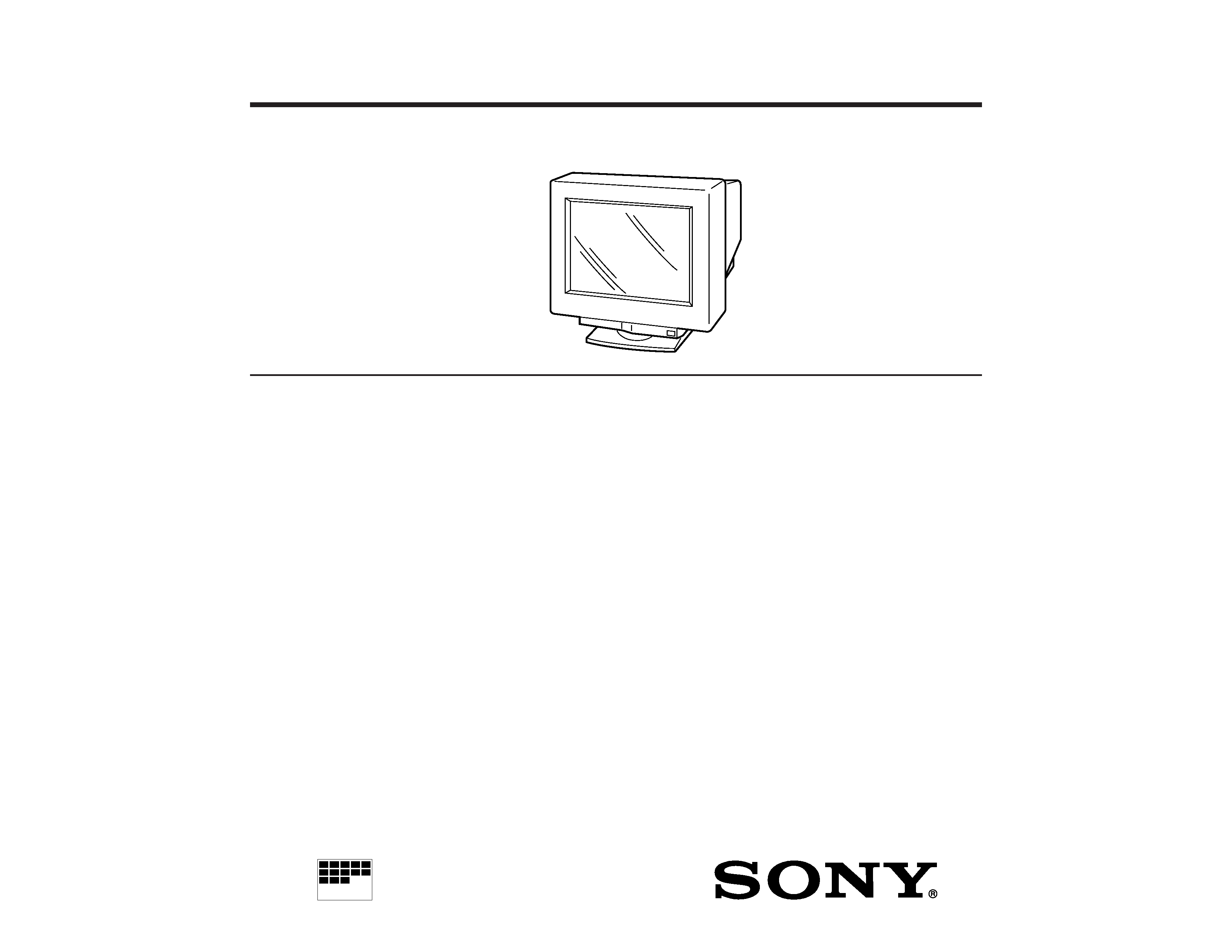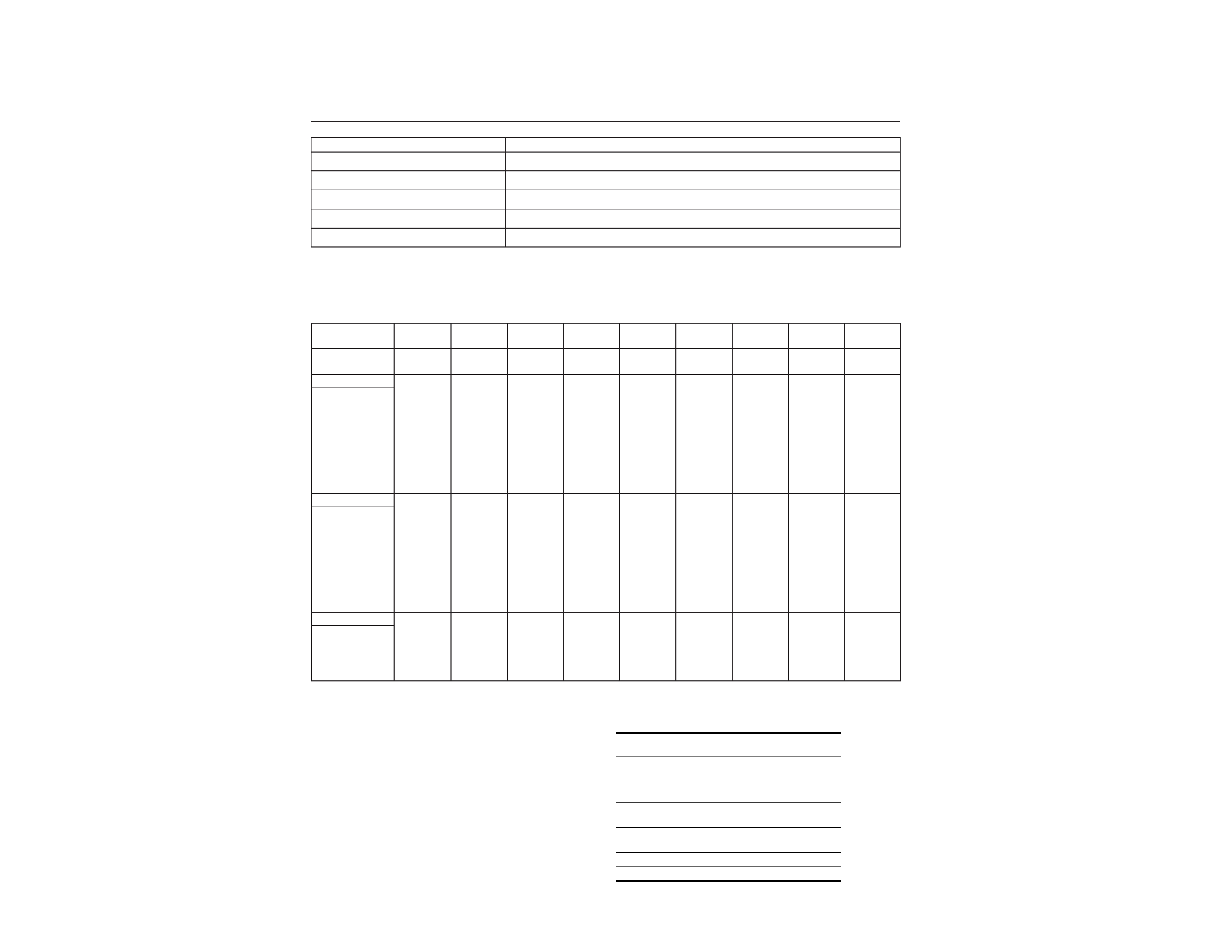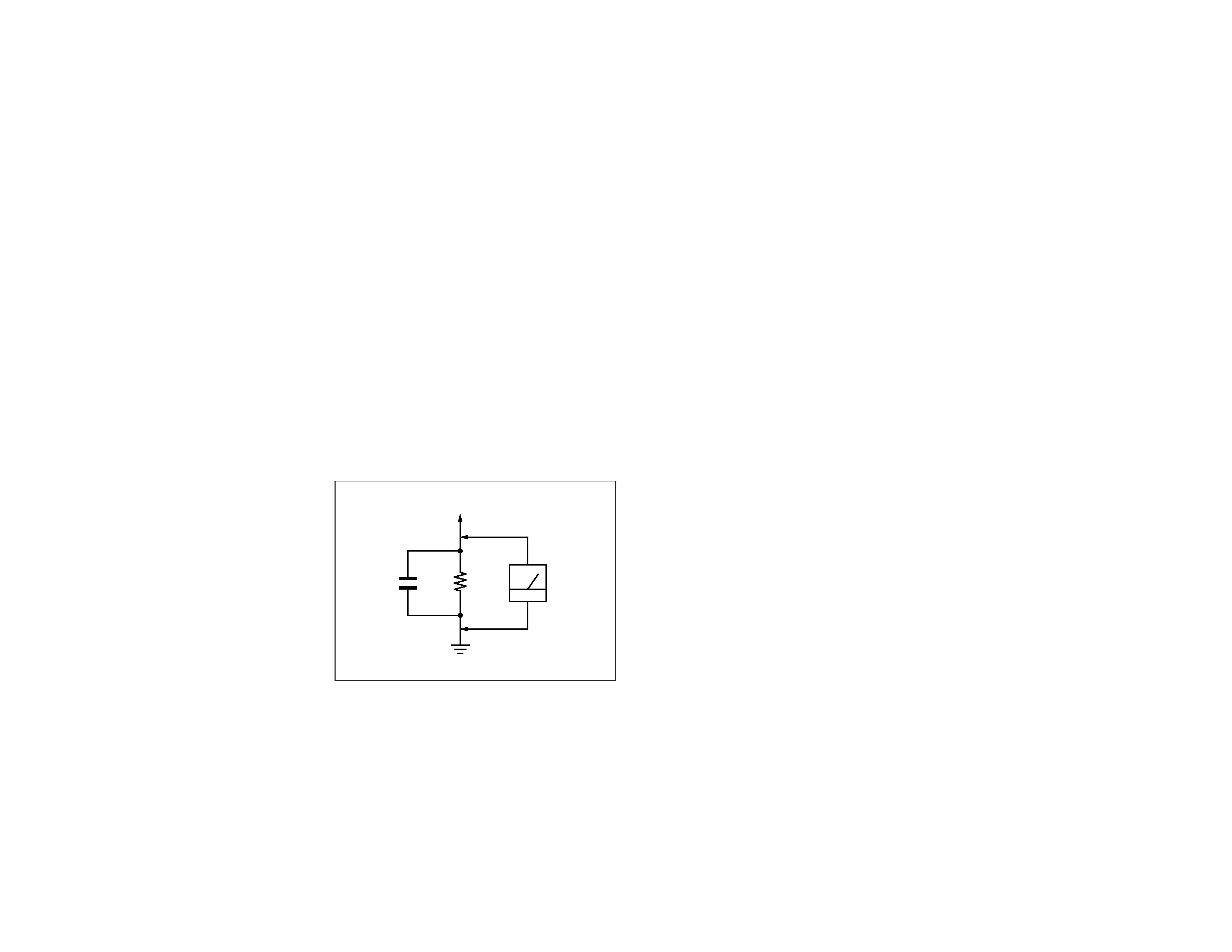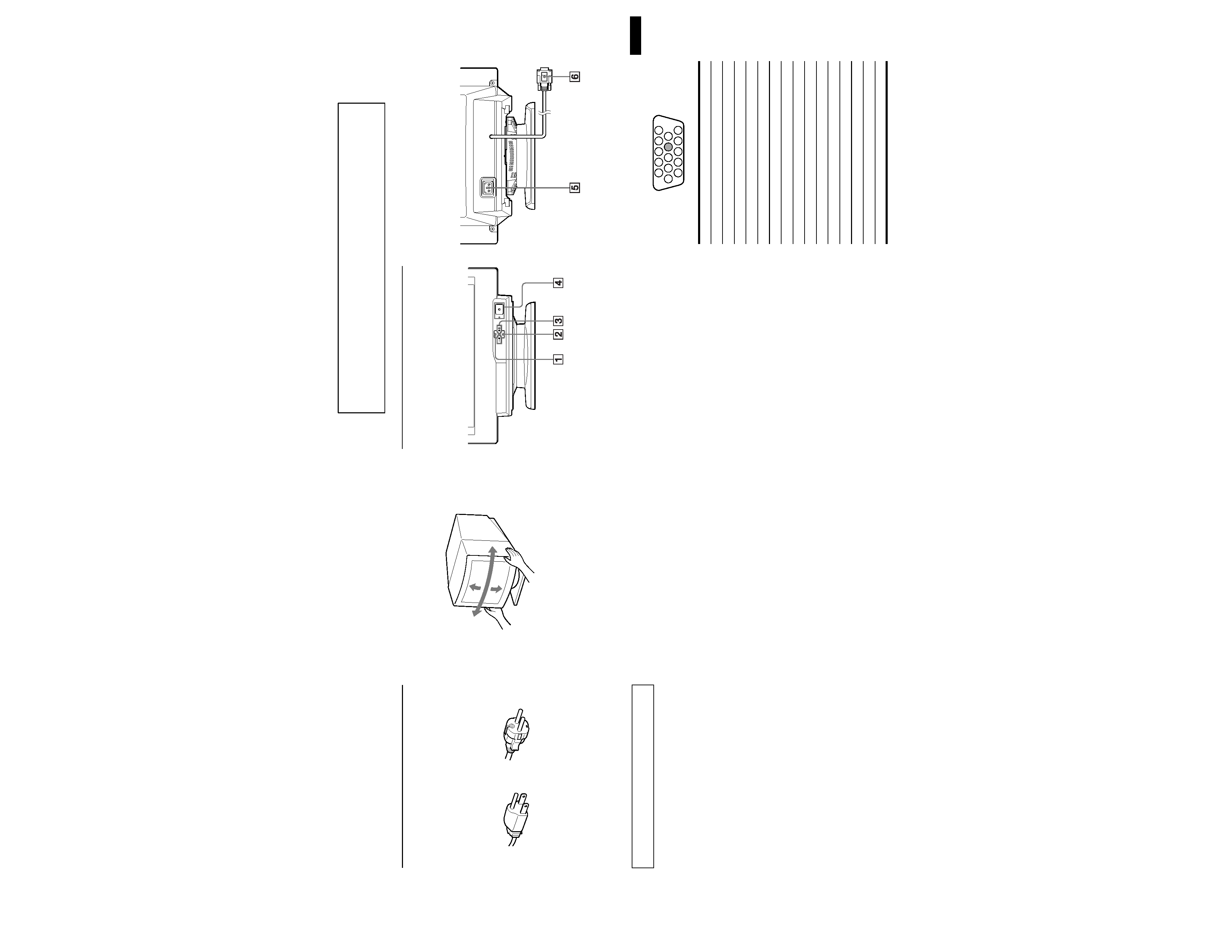
CHASSIS
SERVICE MANUAL
SPECIFICATIONS
MICROFILM
X-110
CPD-110GS
US Model
Canadian Model
Chassis No. SCC-L27A-A
TRINITRON® COLOR COMPUTER DISPLAY
CPD-110GS/110EST
CRT
0.25 mm aperture grille pitch
15 inches measured diagonally
90-degree deflection
Viewable image size
Approx. 285
× 214 mm (w/h)
(11 1/4
× 8 1/2 inches)
14.0" viewing image
Resolution
Horizontal: Max. 1280 dots
Vertical: Max. 1024 lines
Standard image area
Approx. 270
× 202 mm (w/h)
(10 3/4
× 8 inches)
Deflection frequency*
Horizontal: 30 to 70 kHz
Vertical: 48 to 120 Hz
AC input voltage/current
100 to 240 V, 50 60 Hz, 1.6 0.8 A
Power consumption
Max. 105 W
Dimensions
Approx. 368
× 393 × 389 mm (w/h/d)
(14 1/2
× 15 1/2 × 15 3/8 inches)
Mass
Approx. 14 kg (30 lb 14 oz)
Plug and Play
DDC1/DDC2B
Supplied accessories
See page 6
* Recommended horizontal and vertical timing condition
· Horizontal sync width should be more than 1.0 µsec.
· Horizontal blanking width should be more than 3.6 µsec.
· Vertical blanking width should be more than 500 µsec.
Design and specifications are subject to change without notice.
CPD-110EST
AEP Model
Chassis No. SCC-L27B-A
REVISED

CPD-110GS/110EST
2
Failure
Power LED
HV or H STOP or +B Failure
Blink Amber (On 0.5 sec, Off 0.5 sec)
V Stop Failure
Blink Amber (On 1.5 sec, Off 0.5 sec)
Aging/Self-Test
Blink Amber (On 0.5 sec, Off 0.5 sec) .... Blink Green (On 0.5 sec, Off 0.5 sec)
Out of Range
On Green (OSD Indication)
No Input Signal
On Green (OSD Indication)
DIAGNOSIS
TIMING SPECIFICATION
PRIMARY MODE
PRIMARY
MODE AT PRODUCTION
MODE 1
MODE 2
MODE 3
MODE 4
MODE 5
MODE 6
MODE 7
MODE 8
MODE 9
RESOLUTION
640 X 480
640 X 480
720 X 400
800 X 600
800 X 600
832 X 624
1024 X 768
1024 X 768
1280 X 1024
CLOCK
25.175 MHZ
36.000 MHZ
28.322 MHZ
49.500 MHZ
56.250 MHZ
57.283 MHZ
78.750 MHZ
94.500 MHZ
108.000 MHZ
-- HORIZONTAL --
H-FREQ
31.469 kHz
43.269 kHz
31.469 kHz
46.875 kHz
53.674 kHz
49.725 kHz
60.024 kHz
68.677 kHz
63.981 kHz
usec
usec
usec
usec
usec
usec
usec
usec
usec
H. TOTAL
31.778
23.111
31.777
21.333
18.631
20.111
16.660
14.561
15.630
H. BLK
6.356
5.333
6.355
5.172
4.409
5.586
3.657
3.725
3.778
H. FP
0.636
1.556
0.636
0.323
0.569
0.559
0.203
0.508
0.444
H. SYNC
3.813
1.556
3.813
1.616
1.138
1.117
1.219
1.016
1.037
H. BP
1.907
2.222
1.907
3.232
2.702
3.910
2.235
2.201
2.296
H. ACTIV
25.422
17.778
25.422
16.162
14.222
14.524
13.003
10.836
11.852
-- VERTICAL --
V. FREQ(HZ)
59.940 Hz
85.008 Hz
70.087 Hz
75.000 Hz
85.061 Hz
74.550 Hz
75.030 Hz
84.997 Hz
60.020 Hz
lines
lines
lines
lines
lines
lines
lines
lines
lines
V. TOTAL
525
509
449
625
631
667
800
808
1066
V. BLK
45
29
49
25
31
43
32
40
42
V. FP
10
1
12
1
1
1111
V. SYNC
2
3233
3333
V. BP
33
25
35
21
27
39
28
36
38
V. ACTIV
480
480
400
600
600
624
768
768
1024
-- SYNC --
INT(G)
NO
NO
NO
NO
NO
NO
NO
NO
NO
EXT(H/V)/POLARITY
YES -/-
YES -/-
YES -/+
YES +/+
YES +/+
YES -/-
YES +/+
YES +/+
YES +/+
EXT(CS)/POLARITY
NO
NO
NO
NO
NO
NO
NO
NO
NO
INT/NON INT
NON INT
NON INT
NON INT
NON INT
NON INT
NON INT
NON INT
NON INT
NON INT
98.12.10 VER.
Power mode
Power
consumption
1 (power) indicator
normal
operation
110 W
(CPD-210GS)
105 W
(CPD-110GS)
green
1 standby
15 W
green and orange
alternate
2 suspend
15 W
green and orange
alternate
3 active off*
5 W
orange
power off
0 W
off
Power saving function
This monitor meets the power-saving guidelines set by VESA,
ENERGY STAR, and NUTEK. If the monitor is connected to a
computer or video graphics board that is DPMS (Display Power
Management Signaling) compliant, the monitor will
automatically reduce power consumption in three stages as shown
below.
* When your computer enters the "active off" mode, the input signal is
cut and NO INPUT SIGNAL appears on the screen. After 20 seconds,
the monitor enters the power saving mode.

CPD-110GS/110EST
3
LEAKAGE TEST
The AC leakage from any exposed metal part to earth ground
and from all exposed metal parts to any exposed metal part hav-
ing a return to chassis, must not exceed 0.5 mA (500
microampers).
Leakage current can be measured by any one of three methods.
1. A commercial leakage tester, such as the Simpson 229 or
RCA WT-540A. Follow the manufacturers' instructions to
use these instruments.
2. A battery-operated AC milliammeter. The Data Precision
245 digital multimeter is suitable for this job.
3. Measuring the voltage drop across a resistor by means of a
VOM or battery-operated AC voltmeter. The "limit" indica-
tion is 0.75 V, so analog meters must have an accurate low-
voltage scale. The Simpson 250 and Sanwa SH-63Trd are
examples of a passive VOMs that are suitable. Nearly all
battery operated digital multimeters that have a 2 V AC
range are suitable. (See Fig. A)
WARNING!!
NEVER TURN ON THE POWER IN A CONDITION IN
WHICH THE DEGAUSS COIL HAS BEEN REMOVED.
SAFETY-RELATED COMPONENT WARNING!!
COMPONENTS IDENTIFIED BY SHADING AND MARK
¡ ON THE SCHEMATIC DIAGRAMS, EXPLODED
VIEWS AND IN THE PARTS LIST ARE CRITICAL FOR
SAFE OPERATION. REPLACE THESE COMPONENTS
WITH SONY PARTS WHOSE PART NUMBERS AP-
PEAR AS SHOWN IN THIS MANUAL OR IN SUPPLE-
MENTS PUBLISHED BY SONY. CIRCUIT ADJUST-
MENTS THAT ARE CRITICAL FOR SAFE OPERATION
ARE IDENTIFIED IN THIS MANUAL. FOLLOW THESE
PROCEDURES WHENEVER CRITICAL COMPONENTS
ARE REPLACED OR IMPROPER OPERATION IS SUS-
PECTED.
AVERTISSEMENT!!
NE JAMAIS METTRE SOUS TENSION QUAND LA
BOBINE DE DEMAGNETISATION EST ENLEVÉE.
ATTENTION AUX COMPOSANTS RELATIFS À LA
SÉCURITÉ!!
LES COMPOSANTS IDENTIFIÉS PAR UNE TRAME ET
UNE MARQUE
¡ SONT CRITIQUES POUR LA SÉCURITÉ.
NE LES REMPLACER QUE PAR UNE PIÈCE PORTANT LE
NUMÉRO SPECIFIÉ. LES RÉGLAGES DE CIRCUIT DONT
L'IMPORTANCE EST CRITIQUE POUR LA SÉCURITÉ DU
FONCTIONNEMENT SONT IDENTIFIÉS DANS LE
PRÉSENT MANUEL. SUIVRE CES PROCÉDURES LORS
DE CHAQUE REMPLACEMENT DE COMPOSANTS CRI-
TIQUES, OU LORSQU'UN MAUVAIS FONCTIONNE-MENT
EST SUSPECTÉ.
After correcting the original service problem, perform the fol-
lowing safety checks before releasing the set to the customer:
1. Check the area of your repair for unsoldered or poorly-sol-
dered connections. Check the entire board surface for solder
splashes and bridges.
2. Check the interboard wiring to ensure that no wires are
"pinched" or contact high-wattage resistors.
3. Check that all control knobs, shields, covers, ground straps,
and mounting hardware have been replaced. Be absolutely
certain that you have replaced all the insulators.
4. Look for unauthorized replacement parts, particularly tran-
sistors, that were installed during a previous repair. Point
them out to the customer and recommend their replacement.
5. Look for parts which, though functioning, show obvious
signs of deterioration. Point them out to the customer and
recommend their replacement.
6. Check the line cords for cracks and abrasion. Recommend
the replacement of any such line cord to the customer.
7. Check the B+ and HV to see if they are specified values.
Make sure your instruments are accurate; be suspicious of
your HV meter if sets always have low HV.
8. Check the antenna terminals, metal trim, "metallized"
knobs, screws, and all other exposed metal parts for AC
Leakage. Check leakage as described below.
Fig. A. Using an AC voltmeter to check AC leakage.
SAFETY CHECK-OUT
1.5 k
0.15
µF
AC
Voltmeter
(0.75 V)
To Exposed Metal
Parts on Set
Earth Ground

CPD-110GS/110EST
4
TABLE OF CONTENTS
Section
Title
Page
1. GENERAL .................................................................. 1-1
2. DISASSEMBLY
2-1.
Cabinet Removal ................................................. 2-1
2-2.
Service Position ................................................... 2-1
2-3.
D Board Removal ................................................. 2-1
2-4.
Picture Tube Removal .......................................... 2-2
2-5.
Harnes Location ................................................... 2-3
3. SAFETY RELATED ADJUSTMENT ............. 3-1
4. ADJUSTMENTS ...................................................... 4-1
5. DIAGRAMS
5-1.
Block Diagrams
(with Frame Schematic Diagram) ....................... 5-1
5-2.
Circuit Boards Location ...................................... 5-5
5-3.
Schematic Diagrams and Printed Wiring Boards ... 5-5
(1) Schematic Diagram of D-a Board ......................... 5-6
(2) Schematic Diagram of D-b Board ......................... 5-9
(3) Schematic Diagram of D-c Board ........................ 5-13
(4) Schematic Diagram of A Board ........................... 5-17
5-4. Semiconductors ................................................... 5-20
6. EXPLODED VIEWS
6-1.
Chassis ................................................................. 6-1
6-2.
Packing Materials ................................................ 6-2
7. ELECTRICAL PARTS LIST ............................ 7-1

1-1
SECTION 1
GENERAL
The operating instructions mentioned here are partial abstracts
from the Operating Instruction Manual. The page numbers of
the Operating Instruction Manual remein as in the manual.
4
Precautions
Warning on power connections
· Use the supplied power cord. If you use a different power cord,
be sure that it is compatible with your local power supply.
For the customers in the U.S.A.
If you do not use the appropriate cord, this monitor will not
conform to mandatory FCC standards.
· Before disconnecting the power cord, wait at least 30 seconds
after turning off the power to allow the static electricity on the
screen's surface to discharge.
· After the power is turned on, the screen is demagnetized
(degaussed) for about 5 seconds. This generates a strong
magnetic field around the screen which may affect data stored
on magnetic tapes and disks placed near the monitor. Be sure to
keep magnetic recording equipment, tapes, and disks away
from the monitor.
Installation
Do not install the monitor in the following places:
· on surfaces (rugs, blankets, etc.) or near materials (curtains,
draperies, etc.) that may block the ventilation holes
· near heat sources such as radiators or air ducts, or in a place
subject to direct sunlight
· in a place subject to severe temperature changes
· in a place subject to mechanical vibration or shock
· on an unstable surface
· near equipment which generates magnetism, such as a
transformer or high voltage power lines
· near or on an electrically charged metal surface
Maintenance
· Clean the screen with a soft cloth. If you use a glass cleaning
liquid, do not use any type of cleaner containing an anti-static
solution or similar additive as this may scratch the screen's
coating.
· Do not rub, touch, or tap the surface of the screen with sharp or
abrasive items such as a ballpoint pen or screwdriver. This type
of contact may result in a scratched picture tube.
· Clean the cabinet, panel and controls with a soft cloth lightly
moistened with a mild detergent solution. Do not use any type
of abrasive pad, scouring powder or solvent, such as alcohol or
benzene.
Transportation
When you transport this monitor for repair or shipment, use the
original carton and packing materials.
Use of the tilt-swivel
This monitor can be adjusted within the angles shown below. To
turn the monitor vertically or horizontally, hold it at the bottom
with both hands.
The equipment should be installed near an easily accessible
outlet.
Example of plug types
for 100 to 120 V AC
for 200 to 240 V AC
90°
5°
90°
15°
5
US
Identifying parts and controls
See the pages in parentheses for further details.
1 MENU button (page 9)
This button displays the MENU OSD.
2 ENTER button (page 9)
This button selects the menu and adjustment items.
3
6 (contrast)
+/- buttons (page 9)
These buttons display the CONTRAST/BRIGHTNESS menu
and function as the
+/- buttons when adjusting other items.
4
1 (power) switch and indicator (pages 6, 13, 16)
This button turns the monitor on and off. The power indicator
lights up in green when the monitor is turned on, and either
flashes in green and orange, or lights up in orange when the
monitor is in power saving mode.
5 AC IN connector (page 6)
This connector provides AC power to the monitor.
6 Video input connector (HD15) (page 6)
This connector inputs RGB video signals (0.700 Vp-p,
positive) and sync signals.
* DDC (Display Data Channel) is a standard of VESA.
MENU
ENTER
Rear
Front
Pin No.
Signal
1
Red
2
Green
3
Blue
4
ID (Ground)
5
DDC Ground*
6
Red Ground
7
Green Ground
8
Blue Ground
9
10
Ground
11
ID (Ground)
12
Bi-Directional Data (SDA)*
13
H. Sync
14
V. Sync
15
Data Clock (SCL)*
1 2
3 4 5
8
7
6
11 12 13 14 15
10
9
